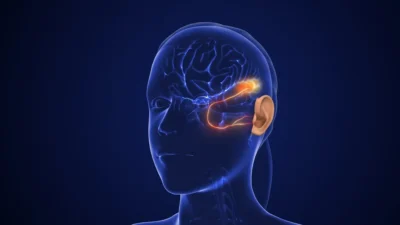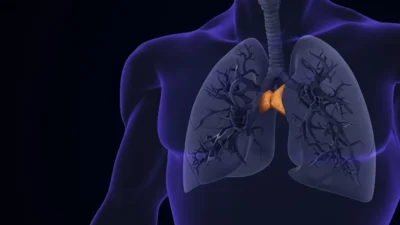Researchers have found that men and women have significant differences in how their brains’ blood vessels change in Alzheimer’s disease.
The collapse of the blood-brain barrier
This research begins with a discussion of Alzheimer’s and its two principal symptoms: the well-known plaques that coat the brain, and the tau proteins that aggregate in neurons. However, targeting either of these proteins after they have already been formed has not been effective in preventing neurons from dying or stopping cognitive decline [1]. These researchers hypothesize that such interventions simply occur too late. Therefore, they chose to focus on something that occurs much earlier in the process: the decline of the blood-brain barrier (BBB) [2].
This decline is precipitated by vascular aging, which has been recently reported to be associated with Alzheimer’s disease [3]. Men and women do not experience vascular aging in precisely the same way [4, 5]. In older women, a decrease in estrogen causes vascular decline [6], making them more susceptible to Alzheimer’s [7].
Gene expressions in Alzheimer’s differ by sex
This research began with a gene expression analysis using samples from 428 people, looking for differentially experienced genes between Alzheimer’s patients and people who did not have the disease. There were no significant differences between the sexes in cellular numbers. In all Alzheimer’s patients, gene expressions in the prefrontal cortex that were related to the vascular system were altered, while in other regions, the gene expression differences were largely related to neuronal support.
These prefrontal cortex differences were much more pronounced in men. Further analysis found that they were largely found in endothelial cells, which line blood vessel walls and form the BBB. Many of these gene expression differences had already been noted as being risk factors for Alzheimer’s.
Men and women did share some similarities in how their genes changed expression with Alzheimer’s, most notably in the metabolism of lipids (fats) and in neuroprotective genes. However, many of the endothelial cells’ gene expression differences were not the same in men and women, and often, they were in opposite directions; some of the relevant genes that are commonly upregulated in men with Alzheimer’s were likely to be downregulated in women with the disease and vice versa.
The hypoxic response
One of the most critical gene sets involved the hypoxic response, which occurs when cells don’t get enough oxygen. The downstream pathways involved in hypoxia were activated in men but not women. The researchers were even able to confirm this in model mice; just like in people, male mice with Alzheimer’s activated the hypoxic response, while female mice did not.
One consequence of the hypoxic response is angiogenesis: the creation of new blood vessels. Genes related to the hypoxic response leading to angiogenesis were strongly upregulated in men with Alzheimer’s, but in women, they were not. However, in women, a different gene, PIK3C2A, was upregulated that leads to angiogenesis; the researchers suggest that this may be a druggable target for men, who do not normally upregulate it.
The researchers investigated a core pathway involved in angiogenesis in women. CREB1 affects vascular endothelial growth factor (VEGF), which affects angiogenesis and endothelial cells. They noted previous work showing that estrogen strongly affects this pathway [8] and that the protein CREB has been investigated as a druggable target in Alzheimer’s.
Estrogen also affects CREB1, and these researchers pinpointed the menopause-related decline in estrogen as being key to the onset of Alzheimer’s in women. An estrogen receptor and a receptor for a hypoxia-inducible factor both have many of the same downstream targets, and menopause is a significant risk factor for vascular disease [9]. Therefore, these researchers believe that men retain a key protection in the blood-brain barrier that post-menopausal women do not. Hormone replacement therapy for older women, therefore, may be found to be necessary to prevent late-life Alzheimer’s, or another method of activating the relevant angiogenesis pathways may be found.
Literature
[1] Godyń, J., Jończyk, J., Panek, D., & Malawska, B. (2016). Therapeutic strategies for Alzheimer’s disease in clinical trials. Pharmacological Reports, 68(1), 127-138.
[2] Sweeney, M. D., Zhao, Z., Montagne, A., Nelson, A. R., & Zlokovic, B. V. (2018). Blood-brain barrier: from physiology to disease and back. Physiological reviews.
[3] Oh, H. S. H., Rutledge, J., Nachun, D., Pálovics, R., Abiose, O., Moran-Losada, P., … & Wyss-Coray, T. (2023). Organ aging signatures in the plasma proteome track health and disease. Nature, 624(7990), 164-172.
[4] Ji, H., Kwan, A. C., Chen, M. T., Ouyang, D., Ebinger, J. E., Bell, S. P., … & Cheng, S. (2022). Sex differences in myocardial and vascular aging. Circulation research, 130(4), 566-577.
[5] DuPont, J. J., Kim, S. K., Kenney, R. M., & Jaffe, I. Z. (2021). Sex differences in the time course and mechanisms of vascular and cardiac aging in mice: role of the smooth muscle cell mineralocorticoid receptor. American Journal of Physiology-Heart and Circulatory Physiology, 320(1), H169-H180.
[6] Moreau, K. L., Hildreth, K. L., Meditz, A. L., Deane, K. D., & Kohrt, W. M. (2012). Endothelial function is impaired across the stages of the menopause transition in healthy women. The Journal of Clinical Endocrinology & Metabolism, 97(12), 4692-4700.
[7] Arvanitakis, Z., Capuano, A. W., Leurgans, S. E., Bennett, D. A., & Schneider, J. A. (2016). Relation of cerebral vessel disease to Alzheimer’s disease dementia and cognitive function in elderly people: a cross-sectional study. The Lancet Neurology, 15(9), 934-943.
[8] Burtscher, J., Mallet, R. T., Burtscher, M., & Millet, G. P. (2021). Hypoxia and brain aging: Neurodegeneration or neuroprotection?. Ageing research reviews, 68, 101343.
[9] El Khoudary, S. R., Aggarwal, B., Beckie, T. M., Hodis, H. N., Johnson, A. E., Langer, R. D., … & American Heart Association Prevention Science Committee of the Council on Epidemiology and Prevention; and Council on Cardiovascular and Stroke Nursing. (2020). Menopause transition and cardiovascular disease risk: implications for timing of early prevention: a scientific statement from the American Heart Association. Circulation, 142(25), e506-e532.









